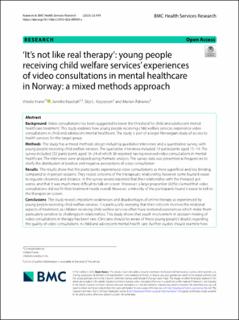| dc.contributor.author | Krane, Vibeke | |
| dc.contributor.author | Kaasbøll, Jannike | |
| dc.contributor.author | Kaspersen, Silje Lill | |
| dc.contributor.author | Ådnanes, Marian | |
| dc.date.accessioned | 2024-02-12T10:27:20Z | |
| dc.date.available | 2024-02-12T10:27:20Z | |
| dc.date.created | 2023-09-07T11:04:38Z | |
| dc.date.issued | 2023 | |
| dc.identifier.citation | BMC Health Services Research. 2023, 23 (1), 1-12. | en_US |
| dc.identifier.issn | 1472-6963 | |
| dc.identifier.uri | https://hdl.handle.net/11250/3116834 | |
| dc.description.abstract | Background: Video consultations has been suggested to lower the threshold for child and adolescent mental healthcare treatment. This study explores how young people receiving child welfare services experience video consultations in child and adolescent mental healthcare. The study is part of a larger Norwegian study of access to health services for this target group. Methods: The study has a mixed methods design including qualitative interviews and a quantitative survey, with young people receiving child welfare services. The qualitative interviews included 10 participants aged 15–19. The survey included 232 participants aged 16–24 of which 36 reported having received video consultations in mental healthcare. The interviews were analysed using thematic analysis. The survey data was presented as frequencies to clarify the distribution of positive and negative perceptions of video consultation. Results: The results show that the participants experienced video consultations as more superficial and less binding, compared to in-person sessions. They raised concerns of the therapeutic relationship, however some found it easier to regulate closeness and distance. In the survey several reported that their relationship with the therapist got worse, and that it was much more difficult to talk on screen. Moreover, a large proportion (42%) claimed that video consultations did not fit their treatment needs overall. However, a minority of the participants found it easier to talk to the therapist on screen. Conclusions The study reveals important weaknesses and disadvantages of online therapy as experienced by young people receiving child welfare services. It is particularly worrying that their criticism involves the relational aspects of treatment, as children receiving child welfare services often have relational experiences which make them particularly sensitive to challenges in relationships. This study shows that youth involvement in decision making of video consultations in therapy has been rare. Clinicians should be aware of these young people’s doubts regarding the quality of video consultations in child and adolescent mental health care. Further studies should examine how user involvement can be incorporated in video consultations in therapy and how this could improve experiences and the quality of video consultations. | en_US |
| dc.description.abstract | ‘It’s not like real therapy’: young people receiving child welfare services’ experiences of video consultations in mental healthcare in Norway: a mixed methods approach | en_US |
| dc.language.iso | eng | en_US |
| dc.publisher | BioMed Central Ltd. | en_US |
| dc.rights | Navngivelse 4.0 Internasjonal | * |
| dc.rights.uri | http://creativecommons.org/licenses/by/4.0/deed.no | * |
| dc.title | ‘It’s not like real therapy’: young people receiving child welfare services’ experiences of video consultations in mental healthcare in Norway: a mixed methods approach | en_US |
| dc.title.alternative | ‘It’s not like real therapy’: young people receiving child welfare services’ experiences of video consultations in mental healthcare in Norway: a mixed methods approach | en_US |
| dc.type | Peer reviewed | en_US |
| dc.type | Journal article | en_US |
| dc.description.version | publishedVersion | en_US |
| dc.source.pagenumber | 1-12 | en_US |
| dc.source.volume | 23 | en_US |
| dc.source.journal | BMC Health Services Research | en_US |
| dc.source.issue | 1 | en_US |
| dc.identifier.doi | 10.1186/s12913-023-09939-x | |
| dc.identifier.cristin | 2173165 | |
| cristin.ispublished | true | |
| cristin.fulltext | original | |
| cristin.qualitycode | 2 | |

